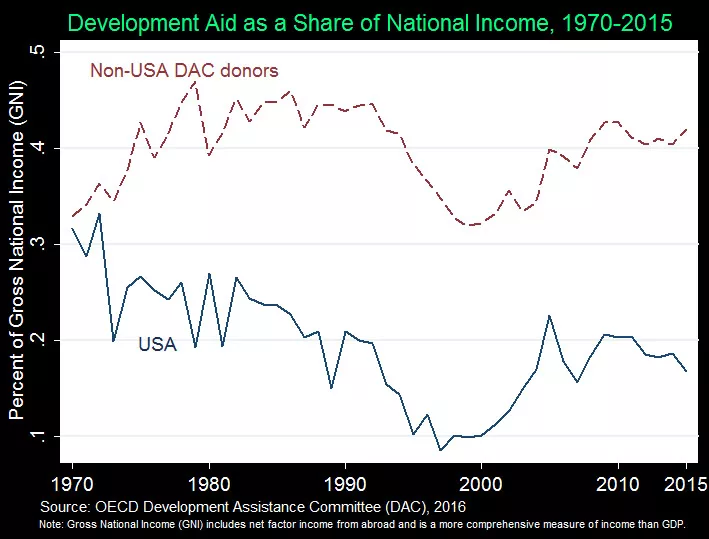Economist Stephen O'Connell on Benefit of U.S. Aid to Sub-Saharan Africa

Econofact: What the U.S. Gains From its Development Aid to Sub-Saharan Africa
The Issue:
Is the U.S. spending too much on foreign aid to Sub-Saharan Africa? One view is that we have pressing problems at home that we should address before we give money to other countries. The Trump administration’s skeptical queries to the State Department’s Africa Bureau reflect this line of questioning and suggest a potentially sharp reduction in White House support for aid to the continent. But many argue that aid to Sub-Saharan Africa is more than justified by its results, both in moral terms and in the economic and security benefits it generates for our country. Some view the political transition in the U.S. as a crucial opportunity to improve the effectiveness of U.S. aid by reforming how aid is managed.
The Facts:
- The financial burden of foreign aid is much smaller than most Americans think. The U.S. government spends less than one fifth of 1 percent of national income on official development assistance across the world, about half of what other donor countries spend relative to their incomes (see chart). Foreign aid (which excludes military assistance) accounts for less than 1 percent of the federal budget, a number Americans routinely overestimate by a margin of roughly 20 to 1. Sub-Saharan Africa accounts for about a third of our total aid budget – about 25 cents per person per day in the U.S., by contrast with daily defense outlays of more than $5 per person.
- Critics of foreign aid tend to question its effectiveness and the degree to which it is wasted or ends up in the hands of corrupt governments. Such debates are hard to resolve definitively because circumstances vary widely from one country to another and it is difficult to show what would have happened in the absence of aid. But a comprehensive recent study finds that, on average, aid generates substantial economy-wide benefits to the receiving country. Donors can also point to some spectacular successes in global health. At the project level, U.S. Agencies are increasingly committed to rigorous evaluation and can draw on a growing base of randomized controlled trials (which are widely considered the gold standard in evaluating the impact of a program) to help identify cost-effective interventions.
- Health and humanitarian aid represent more than 80 percent of U.S. aid to Africa and are supported by many Americans. The U.S. continues to lead the global fight against HIV/AIDS and malaria in Africa, with major results and with apparent support from President Trump during the campaign and from Rex Tillerson, Trump's nominee for Secretary of State. For instance, between 2000 and 2015 the number of malaria deaths in children under 5 years in Sub-Saharan Africa dropped from an estimated 694,000 to 292,000 per year. The U.S. is the largest donor towards efforts to combat malaria, contributing 35 percent of global funding. These programs enhance the well-being and productivity of African populations, including girls and women whose access to security, nutrition, health services and education can break the inter-generational transmission of poverty. Programs targeting agricultural productivity, trade facilitation and domestic revenue mobilization in Africa promote cost-effective routes to economic transformation and self-reliance on the continent. Sustained economic growth in Sub-Saharan Africa benefits the U.S. both by reducing the need for assistance and by providing growing markets for U.S. exports and foreign investment.
Stephen O'Connell, the Gil and Frank Mustin Professor of Economics, is an authority on the political economy of Africa and on macroeconomic policy in low-income developing countries. With Benno Ndulu of the World Bank and under the auspices of the African Economic Research Consortium in Nairobi, O'Connell coordinated a large research project on the post-independence economic performance of African countries. The results are presented in The Political Economy of Economic Growth in Africa, 1960-2000, a two-volume study from Cambridge University Press (2008). O'Connell, who joined the Swarthmore faculty in 1990, also served for two years as the chief economist at the United States Agency for International Development.



